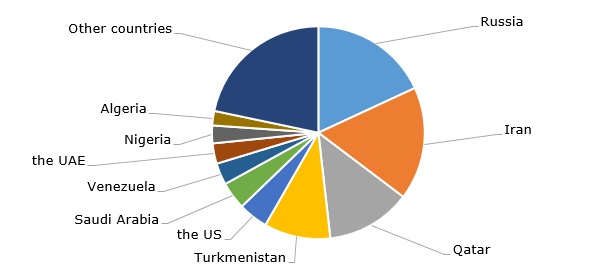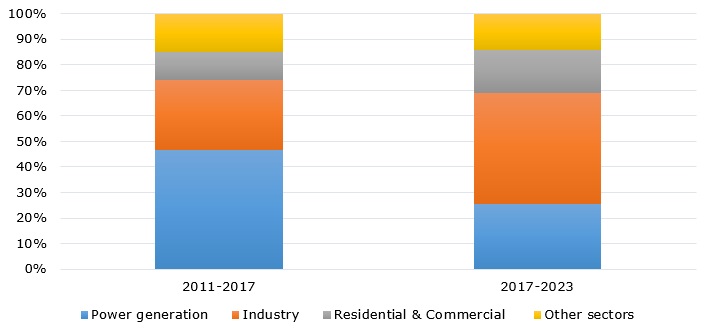Global Natural Gas Consumption to Maintain Upward Momentum
13 Feb 2019 • by Natalie Aster

LONDON – The role of natural gas in the world’s energy mix has increased sizeably over recent years. Today, it accounts for around 23% of the energy used across the globe. For reference, natural gas contributed appr. 19% of the worldwide total volume of primary energy consumption in 1980, whilst in 2016 its share was nearly 22.1%. The consumption volume of different fossil fuels to satisfy the primary energy needs varies from region to region, and the proportion of these energy sources changes in course of time. In the countries of the MENA region and the former Soviet Union, for instance, natural gas tends to displace oil, whilst in North America and Europe, it takes a share from coal.
The global volume of the natural gas proved reserves came up from 5.15 quadrillion cubic feet in the year 2000 to about 6.83 quadrillion cubic feet in the year 2017. Among regions, Middle East accounts for the biggest chunk of the world’s natural gas deposits, followed by CIS and, with a substantial margin, by other regions. As for countries, the vastest reserves of natural gas are found in the US, Turkmenistan, Qatar, Iran, and Russia.
World’s proved natural gas reserves broken down by country, 2017 
Globally, the consumption of natural gas (both in absolute terms and also as a share of total energy usage mix) has increased substantially over recent years. This is majorly attributed to its environmental benefits by contrast to other fossil fuels (particularly associated with greenhouse emissions and air quality). Besides, the escalating consumption of natural gas was supported by changes in economic activity patterns along with the rising shift to natural gas from other energy sources (mainly from oil).
In 2000, the overall natural gas consumption from pole to pole stood at slightly over 2.4 trillion cubic meters (tcm). Between 2000 and 2017, it demonstrated a steady upturn except the year 2009. In 2017, the world’s consumption volume of natural gas exceeded 3.67 tcm.
Meantime, the global production of natural gas also followed an upward trend during 2000-2017, except for a slight decline in 2009. In 2000, the volume of the world’s natural gas output was a little above 2.41 tcm. In 2017, it surpassed 3.68 tcm.
World’s production and consumption of natural gas from 2000 to 2017 (in tcm)
.jpg)
In the long run, natural gas consumption is poised to continue growing at a rather brisk pace. It may even outrun coal as the second largest energy source behind oil in the next 15 years. Across the globe, the demand for natural gas is anticipated to grow at an annual average of appr. 1.5-2% in the next five years, outstripping the demand growth pace of other fossil fuels. By the year 2023, the world’s demand for natural gas is predicted to cross 4.1 tcm.
The emerging Asian market are likely to perform as the major contributors to this growth, with China forecast to see the highest demand increase (nearly 5.2% per year) – the country is poised to account for around a third of the world’s total demand growth and for over 56% of Asia’s demand growth through 2022. Presently, China ranks the third biggest natural gas consumer, accounting for around 6.6% of the world’s total consumption volume. In 2017, the country consumed nearly 240.4 billion cubic meters (bcm) of natural gas. Moreover, this year China is slated to overtake Japan as the world’s dominant natural gas importer.
10 largest natural gas consumers, 2017 (in bcm)
.jpg)
As for the end-use sectors of natural gas, the industrial sector is projected to emerge as the biggest contributor to the global demand growth through 2023, outpacing the power generation sector, which historically had been in the lead. This shift will be particularly notable in the Asian region and other emerging markets due to the expanding usage of natural gas in various industrial processes and also as feedstock for a range of fertilizers and chemicals. Overall, the industrial sector is expected to account for over 40% of the world’s total upturn of natural gas demand between 2017 and 2023, whilst the power generation sector is anticipated to contribute nearly 26%.
Growth of world’s natural gas demand by end-use sector (in %)

The growing consumption volumes are likely to emphasize the marked divisions between the regions that are engaged in the production of natural gas and the regions that consume it. The European countries along with the member-nations of Asian OECD have emerged as the leading natural gas importers, whilst the countries of MENA, North America, and the former Soviet Union lead the way in the natural gas exports. Backed by the growing gap between natural gas consumption and output, the volumes of natural gas traded on the global arena are poised to increase in the foreseeable future. In 2017, the overall volume of natural gas traded around the globe via pipelines totaled some 822 bcm, whilst the trade volume of liquefied natural gas (LNG) was about 393 bcm.
Worldwide natural gas trade volume by mode, 2010-2017 (in bcm) .jpg)
Conclusion
All in all, future prospects of the natural gas industry look bright, and the sector holds a lot of potential for robust growth. The world’s consumption volume of natural gas is set to exhibit a sustained increase in the years ahead spurred by the three noteworthy trends, amid others: 1) the fact, that natural gas causes less pollution of the environment and helps to improve the air quality, is supposed to act as the key growth engine of the world’s demand; 2) China will be at the forefront of the global natural gas consumption upswing; 3) the industrial sector will replace the power generation sector as the top contributor to the natural gas demand upturn. However, the natural gas industry is not without its challenges – to sustain healthy growth rate, the industry needs to keep natural gas prices affordable compared to other fuels (especially in emerging markets), to tackle the problem of methane leaks, and to ensure adequate and timely investments.
© MarketPublishers.com, 2019
Analytics & News
